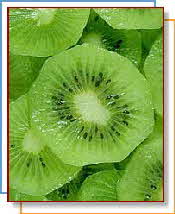Home | FOOD ARTICLES | Food Trivia | Today_in_Food_History | Food_History_Timeline | Recipes | Cooking_Tips | Food_Videos | Food_Quotes | Who’s_Who | Culinary_Schools_&_Tours | Food_Trivia_Quizzes | Food_Poems | Free_Magazines | Food_Festivals_and_Events
Food Articles, News & Features Section
FREE Magazines
and other Publications
Free Professional and Technical Research, White Papers, Case Studies, Magazines, and eBooks
KIWI FRUIT
See also: Mini Kiwifruit
Did You Know
Did you know that kiwifruit is more than 700 years old? Kiwifruit history began in the Yang-tse river valley in China, where it was called "Yangtao." The Yangtao was considered a delicacy by the court of the great Khans who cherished its delicious flavor and emerald-green color. The small, brown, fuzzy "Yangtao" fruit grew wild on vines that wrapped around trees.
Between 1800 and 1900 knowledge of the fruit spread to other countries, and samples of the fruit and seeds were sent to England. In 1904 plant cuttings were brought to the United States (1999 Produce Availability and Merchandising Guide, The Packer. 1999). Seeds were sent to New Zealand in 1906, and the fruit was renamed the "Chinese Gooseberry." New Zealand's "Chinese Gooseberry" variety was first shipped to the United States in 1962, where it was re-named Kiwifruit after New Zealand's national bird the "kiwi." In the 1970s it was grown in California and available for the first time in supermarkets throughout the United States. Most kiwifruit imported to the United States comes from Chile and New Zealand. Kiwifruit is available year-round.

Selection
Select kiwifruit with no bruises or soft spots. Avoid fruits with wrinkles or signs of exterior damage. Buy firm kiwifruit and let them ripen at home for a juicier flavor. A kiwifruit is ripe when plump and slightly soft to the touch with a fragrant smell.
Storage
Ripen kiwifruit at room temperature for 3 to 5 days. If necessary, ripe kiwifruit can be stored in the refrigerator for up to 7 days. If they need to be stored longer, put kiwis in a plastic bag in the refrigerator for up to 2 weeks. The plastic bag helps reduce moisture loss so kiwifruit stays fresh longer. Putting kiwifruit near fruits that produce ethlyene gas, such as apples, bananas or pears, will speed up the ripening process. So if you want to ripen kiwifruit quickly, put kiwi in a bag with these kinds of fruit for a day or two.
Preparation
You can eat the fuzzy skin on the outside of the kiwifruit. The skin is very thin and just needs to be rinsed and rubbed lightly to dry. Then, cut in quarters like an orange and enjoy-skin and all! It's easy to peel kiwifruit. First, cut off the top and bottom ends, and then peel down the sides with a vegetable peeler or knife. Slice or quarter into bite-size pieces and enjoy kiwifruit's refreshing taste.
Varieties
Kiwifruit can be medium or small in size, although most are small. They are brown and fuzzy on the outside and bright green on the inside with tiny black seeds. The shell or skin of the fruit can be eaten or peeled. Kiwifruit is a member of the botanical family Actinidia and there are 400 different varieties. Kiwifruit vines are trained to grow on a trellis, and vines can be as high as 15 feet. This helps plants get enough light and air for optimal fruit quality. The fruit hangs down along the sides, like table grapes. The Hayward variety is the most popular U.S. variety. The flavor is a mixture of peaches, strawberries, and melon with a soft and juicy texture. It's one of the most popular fruits today. Kiwifruit is high in antioxidant vitamin C and a good source of fiber, vitamin E and potassium. It is fat free, sodium free and cholesterol free.
Little known Facts
Did you know kiwifruit could also be used as a natural meat tenderizer? That's because kiwifruit contains an enzyme called Actinidin. Just cut in half and rub kiwifruit over the meat, or peel and mash with a fork then spread it on the surface of the meat and let stand for 10 to 15 minutes or longer. The enzyme Actinidin also breaks down protein in dairy products. That's why when kiwifruit is combined with low fat ice cream, yogurt, or sour cream, it's best to serve and eat it right away.
Make Kiwifruit Part of Your 5 A Day Plan
* Kiwifruit comes with its own serving cup. Just cut them in half through the middle and scoop out each half with a spoon.
* Add one to your lunch box.
* For a spicy delicious treat use it in making salsa to serve over your favorite meat.
* Peel and slice kiwi to use in a fruit salad or top your favorite cereal in the morning.
* Garnish breakfast, lunch, and dinner entrees with kiwifruit slices or wedges.
RELATED ARTICLES
Please feel free to link to any pages of FoodReference.com from your website.
For permission to use any of this content please E-mail: james@foodreference.com
All contents are copyright © 1990 - 2025 James T. Ehler and www.FoodReference.com unless otherwise noted. All rights reserved.
You may copy and use portions of this website for non-commercial, personal use only.
Any other use of these materials without prior written authorization is not very nice and violates the copyright.
Please take the time to request permission.


